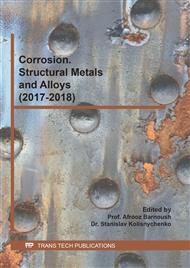[1]
C.W. Chung, R.G. Ding, Y.L. Chiu, M.A. Hodgson, W. Gao, Microstructure and Mechanical Properties of an As-Cast AZ91 Mg Alloy Processed by Equal Channel Angular Pressing, Mat. Sci. and Eng. 4 (2009) 120-128.
DOI: 10.1088/1757-899x/4/1/012012
Google Scholar
[2]
C.W. Chung, R.G. Ding, Y.L. Chiu, W. Gao, Effect of ECAP on microstructure and mechanical properties of cast AZ91 magnesium alloy, J. Phys. 241 (2010) 147-152.
DOI: 10.1088/1742-6596/241/1/012101
Google Scholar
[3]
B. Chen, D.L. Lin, L. Jin, X.Q. Zeng, L. Chen, Equal-channel angular pressing of magnesium alloy AZ91 and its effects on microstructure and mechanical properties, Mat. Sci. and Eng.: A. 483-484 (2008) 113-116.
DOI: 10.1016/j.msea.2006.10.199
Google Scholar
[4]
J. Vrátná, B. Hadzima, M. Bukovina, M. Janeček, Room temperature corrosion properties of AZ31 magnesium alloy processed by extrusion and equal channel angular pressing, J. of Mat. Sci. 48 (2013) 4510-4516.
DOI: 10.1007/s10853-013-7173-4
Google Scholar
[5]
S. Fintová, L. Pantělejev, L. Kunz, Microstructure and Mechanical Properties of Ultrafine-Grained Magnesium AZ91 Alloy, Mat. Sci. For. 782 (2014) 384-389.
DOI: 10.4028/www.scientific.net/msf.782.384
Google Scholar
[6]
A. Yamashita, Z. Horita, T.G. Langdon, Improving the mechanical properties of magnesium and a magnesium alloy through severe plastic deformation. Mat. Sci. and Eng.: A. 300 (2001) 142-147.
DOI: 10.1016/s0921-5093(00)01660-9
Google Scholar
[7]
M. Horynová, J. Zapletal, P. Doležal, P. Gejdoš, Evaluation of fatigue life of AZ31 magnesium alloy fabricated by squeeze casting, Mat. and Des. 45 (2013) 253-264.
DOI: 10.1016/j.matdes.2012.08.079
Google Scholar
[8]
R. Štěpánek, L. Pantělejev, O. Man, Thermal stability of magnesium alloy AZ91 prepared by severe plastic deformation, Mat. Eng. 20 (2013) 160-166.
Google Scholar
[9]
X. Molodova, G. Gottstein, R.J. Hellmig, On the Thermal Stability of ECAP Deformed FCC Metals, Mat. Sci. For. 558-559 (2007) 259-264.
DOI: 10.4028/www.scientific.net/msf.558-559.259
Google Scholar
[10]
M. Gupta, N.M.L. Sharon, Magnesium, Magnesium Alloys, and Magnesium Composites, John Wiley & Sons. 2011. ISBN: 978-0-470-49417-2. p.257.
DOI: 10.1017/s0001924000005972
Google Scholar
[11]
D. Song, A.B. Ma, J.H. Jiang, P.H. Lin, D.H. Yang, J.F. Fan, Corrosion behaviour of bulk ultra-fine grained AZ91D magnesium alloy fabricated by equal-channel angular pressing, Corr. Sci. 53 (2011) 362-373.
DOI: 10.1016/j.corsci.2010.09.044
Google Scholar
[12]
A. Pardo, M.C. Merino, A.E. Coy, R. Arrabal, F. Viejo, E. Matykina, Corrosion behaviour of magnesium/aluminium alloys in 3. 5 wt. % NaCl, Corr. Sci. 50 (2008) 823-834.
DOI: 10.1016/j.corsci.2007.11.005
Google Scholar
[13]
H.S. Kim, W.J. Kim, Enhanced corrosion resistance of ultrafine-grained AZ61 alloy containingvery fine particles of Mg17Al12 phase, Corr. Sci. 75 (2013) 228-238.
DOI: 10.1016/j.corsci.2013.05.032
Google Scholar
[14]
R. Ambat, N.N. Aung, W. Zhou, Evaluation of microstructural effects on corrosion behaviour of AZ91D magnesium alloy, Corr. Sci. 42 (2000) 1433-1455.
DOI: 10.1016/s0010-938x(99)00143-2
Google Scholar
[15]
B. Hadzima, M. Janeček, P. Suchý, J. Müller, L. Wagner, Microstructure and Corrosion Properties of Fine-Grained Mg-Based Alloys, Mat. Sci. For. 584-586 (2008) 994-999.
DOI: 10.4028/www.scientific.net/msf.584-586.994
Google Scholar
[16]
B. Hadzima, T. Liptáková, Fundamentals of electrochemical corrosion of metals, 1. edition. Žilina: EDIS publishers ŽU. 2008. 112 s. ISBN 978-80- 8070-876- 4.
Google Scholar



